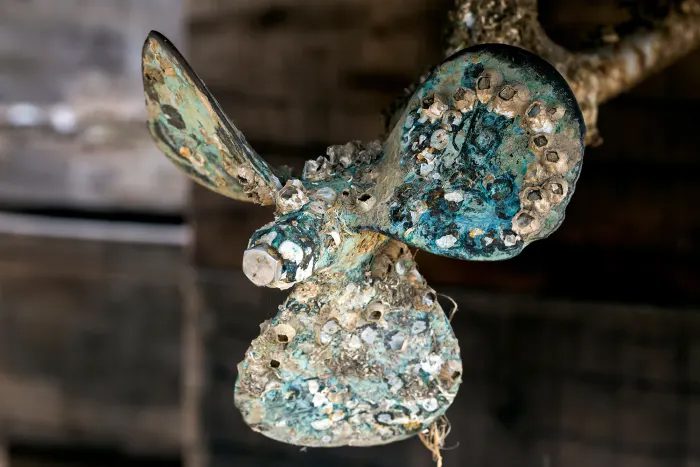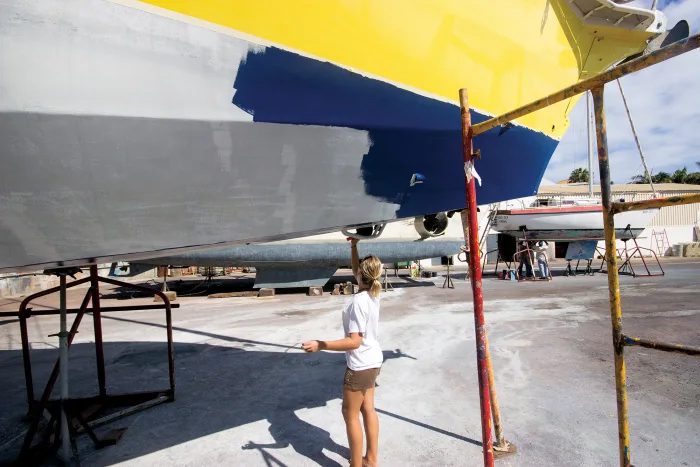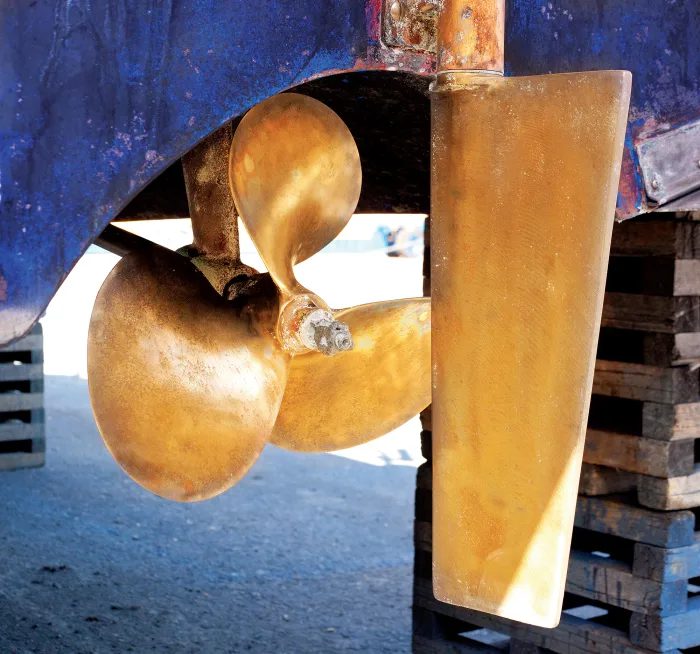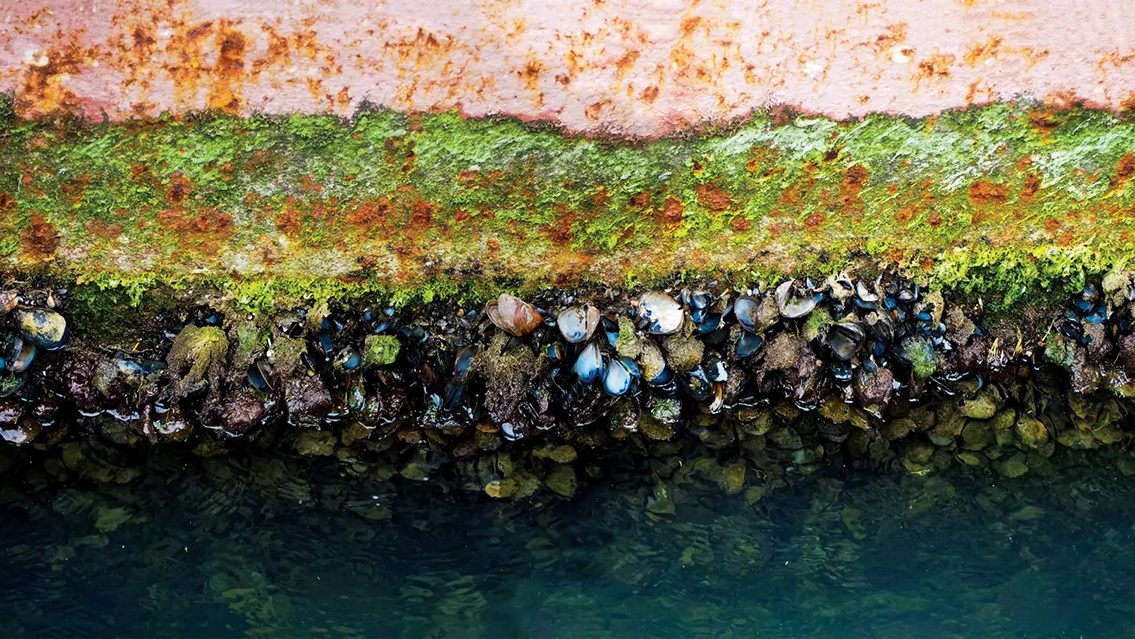Mike Smith on keeping algae, grass and barnacles at bay.
![]()
Mike Smith | Originally published April 2, 2024
Get Moving
When your boat sits still for too long, algae, grass and barnacles take up residence on the bottom, hurting performance and efficiency. Help prevent this by going boating often.

Hull and prop fouling is not only an eyesore; slime and barnacles put a serious damper on your boat’s performance.
Like almost everything, including people, boats stay in good working order when they get used frequently, and they fall into disrepair when they don’t. Metal parts corrode, hoses and V-belts get dry and brittle, fluids leak and wiring mysteriously breaks, usually in a place that’s very hard to reach. Nobody knows how or why that happens, but it does. Below the waterline, grass, slime and barnacles collect on the underwater gear, reducing speed and efficiency and adding to fuel burn when you finally leave the slip.
At haul-out, the yard charges big bucks to scrape off these aquatic squatters. On the other hand, problems tend to go away, or at least decrease, if you use your boat often. So, what are you waiting for? Put down this magazine, get out of the recliner and head for the marina.
The Antifoulers
Modern multi-season antifouling paints are good at repelling grass, barnacles and other invaders even when the boat’s left sitting idle, but they’re not miracle workers. Leave your boat unused for weeks and you’ll find a secret garden living on its bottom, one that won’t be washed off when you finally get underway. Thus, you need to get your boat moving to wash off invaders before they can get a grip. And even if your antifouling is in good shape, there’s always some place aquatic critters can find to glom onto; one of their favorites is your underwater metal. An inboard boat’s props, struts and rudders are the most obvious nesting places for barnacles and marine growth, but through-hulls, external strainers, trim tabs and thrusters will also become fouled faster than you can say “ablative copolymer” if they’re not guarded by an effective coat of antifouling. Painting a bow thruster in a narrow tube can be a pain, but the effort will pay off in better performance: Thrusters obviously don’t work well when they’re clogged with marine growth. And stern drives? Forget about it: Most don’t tilt up clear of the water, and grass and algae will clog any available cooling passages long before Memorial Day weekend. Paint them. Try Total Boat Outdrive AF—it’s copper-free, so it won’t react galvanically with aluminum alloy drives. Always match the antifouling to the metal it’s coating.
Bronze is easy to paint, since it’s mostly copper and won’t react with conventional copper-based antifouling. Back in the day, when everybody called antifouling “copper bottom paint,” most folks used to slap it directly onto their bronze struts, rudders and props—shafts, too, if they were bronze—not bothering with primer or even much preparation other than a quick swipe with a wire brush or coarse sandpaper. (Don’t paint under the anodes.) The paint was thick and goopy, and I wonder what effect it had on propeller efficiency? It probably didn’t matter much since most of the paint on the props would be spun off halfway through the season anyway. The struts and rudders would be almost bare by haul out time, but that just meant less paint to remove in the spring. This lazy-man’s method worked pretty well.

Get the most out of your anitfouling paint by prepping and priming. Sometimes one brand of primer system works better than others in a particular area, so do your homework before investing.
Old-time bottom paint didn’t ablate like the modern stuff; the toxicity would wear off during the season as the copper leached out, leaving an inert paint base that, ideally, was mostly sanded away at spring fitting-out, a time-consuming and costly job that people tended not to do. They just slapped on another coat, so after many seasons most boats carried a thick layer of dead antifouling on their bottoms, which eventually had to be removed—a job often farmed out to kids able to handle a scraper and willing to lie in boatyard mud and breathe toxic paint dust for a buck or two an hour. The new multi-season paints that wear off on their own are way better for all concerned.
There’s other metal besides running gear that needs protection. It doesn’t take many barnacles to clog an external strainer enough to restrict water flow-—which can impair the function of whatever system the strainer serves; if it’s an engine or genset, you’ll likely see overheating, which can cause even more damage. Antifouling will not only keep the critters off the strainer but also deter them from taking up residence in the through-hull itself. But be careful when painting external strainers: Too much paint can restrict water flow as much as marine growth does, so apply a very thin coat. Transducers and underwater lights need antifouling, too, but there are special coatings for them.
Whether to paint stainless alloy propeller shafts depends on who you ask; I never painted stainless shafts, worried that the paint would seal the metal surface and promote crevice corrosion, or somehow cause galvanic action. But plenty of skippers do, and they don’t seem to have any problems. Many boat owners now opt for the foul-release coatings formulated specifically for all underwater metals—more on them below.
Use The System
Unlike the high-copper antifouling of days past, today’s ablative antifouling paints last for multiple seasons when properly applied, so it’s worth doing the job right by prepping and priming the bottom before painting, and that’s especially important when painting underwater metal. Every paint manufacturer has a system of primers and antifouling specifically for metal. Sometimes one brand will work better than others in a particular area, so ask around before investing in a system; the stuff is expensive and time-consuming to apply correctly, so you want to get it right the first time. Ask your marina mates what they use.
Generally, the brand of paint you choose is less important than applying it correctly, which means according to the manufacturer’s instructions. Stick to the system, no matter how hard the guy in the chandlery tries to sell you something that’s cheaper but “just as good.” If you swap the specified primer for a cheaper off-brand and the paint peels off, you can’t complain to the manufacturer—and stripping the bottom to do the job right costs way more than you saved on the cheaper product. Prep and primers for metal are often different from those for a fiberglass hull—it’s difficult at best to get paint to stick to metal, especially a spinning propeller, so give yourself the best shot at success by using the right stuff.
To make it simple, some manufacturers sell packages: Pettit’s Running Gear Guardian, for example, comes in a kit with enough primer and antifouling topcoat to cover 65 square feet. Pettit says that’s enough to paint all underwater metal—props, shafts, struts, trim tabs and through-hulls—on a boat with up to 36-inch twin props, with a little left over for touch-ups. West Marine sells the kits for $220.

Copper’s been a go-to antifouling source since the 1700s, as digestively, mollusks and crustaceans are highly sensitive to it.
Don’t Use Antifouling
Some people don’t use antifouling paint at all, but rely on foul-release coatings that prevent barnacles and other growth from attaching to the metal. Based on silicone, ceramic or other slippery compounds, these multi-layer coatings make the metal so slick that growth can’t stick to it. Leave the boat sitting for weeks and you might still get a layer of growth on the props and rudders, but go for a ride and most of it will slough off, according to the manufacturers. An added advantage, also according to the manufacturers, is improved propeller efficiency thanks to the hard, smooth surface created by the product. Some boat owners I’ve spoken to love these products, while others are not as impressed; I think those who use their boats frequently have better luck, which speaks to the point that I’m trying to make in this column: Use your boat!
The foul-release product everyone’s heard of, and one that seems to work pretty well, is silicone-based Propspeed, but there are others—PropGlide is one, Glidecoat’s ceramic Prop Optimizer another. They can all be applied to almost any metal and will usually last for a couple of years, depending on how you use your boat, but are also costly. A 200-mL Propspeed kit, including all the materials needed to coat a four-bladed prop up to 24 inches diameter, costs about $250. But covering all the underwater gear of a typical mid-size powerboat requires a full liter of Propspeed; 36 square feet of coverage, enough for twin 24-inch props, shafts, struts, rudders and trim tabs. That’ll run you $500 or more in most chandleries.
Some boat owners go another route, and cold-galvanize their underwater metals by coating them with a zinc-based paint. It’s not antifouling, but manufacturers suggest it’ll keep barnacles and growth away. They are mostly zinc so they won’t cause galvanic corrosion of running gear; instead, they might actually provide a little extra anodic corrosion protection. Pettit says their Prop Coat Barnacle Barrier (comes in 16-oz. aerosol, about $40, covers 10 square feet, or a liquid quart, about $115, that covers about 70 square feet) will self-clean when you run the boat, and it’s easy to apply: Sand the metal back to a shiny surface, spray or brush on three coats—then recoat after five minutes, or wait for at least an hour. What could be simpler?
The dried Barnacle Barrier film contains 93 percent zinc. Coating with a compatible antifouling will make the Barnacle Barrier work even better, according to Pettit, but it’s not necessary. Rustoleum and many other manufacturers sell cold galvanizing sprays that sound a lot like Barnacle Barrier, with 93 percent zinc, for quite a bit less money; they’re not advertised for use underwater, but anecdotal evidence suggests they work just fine.
And to repeat: Whatever you choose to use on your underwater metal, it’ll work a lot better if you use your boat often. Letting your boat become a marina queen, sitting in the slip growing stuff on her bottom, will tax the abilities of even the best antifouling. Fire up the engines and get her moving, or pay the price in increased maintenance and repairs later on. And isn’t getting underway the reason you bought the boat in the first place? So get out there and enjoy the water, on your nice, clean bottom.

